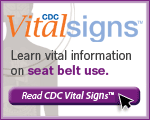Seat Belts Fact Sheet
Motor vehicle crashes are the leading cause of death among those age 5-34 in the U.S.1 More than 2.3 million adult drivers and passengers were treated in emergency departments as the result of being injured in motor vehicle crashes in 2009.2 Adult seat belt use is the most effective way to save lives and reduce injuries in crashes.3 Yet millions of adults do not wear their seat belts on every trip.2
How big is the problem of crash-related injuries and death?
Motor vehicle crashes are a major public health problem.
- More than 2.3 million adult drivers and passengers were treated in emergency departments as the result of being injured in motor vehicle crashes in 2009.2
- The lifetime costs of crash-related deaths and injuries among drivers and passengers were $70 billion in 2005.4
- Young adults (18-24) have the highest crash-related injury rates of all adults.2
What is the impact of seat belt use?
- Seat belts reduce serious crash-related injuries and deaths by about 50%.5
- Air bags provide added protection but are not a substitute for seat belts. Air bags plus seat belts provide the greatest protection for adults.6
Who is least likely to wear a seat belt?
- Adults age 18-34 are less likely to wear seat belts than adults 35 or older. (CDC, 2010, unpublished data)
- Men are 10% less likely to wear seat belts than women. (CDC, 2010, unpublished data)
- Adults who live in rural areas are 10% less likely to wear seat belts (78% use) than adults who live in urban and suburban areas (87% use). (CDC, 2010, unpublished data)
- Seat belt use is lower in states with secondary enforcement seat belt laws or no seat belt laws (79%) compared to states with primary enforcement laws (88%).2
Primary Enforcement Laws Make a Difference
Primary enforcement seat belt laws make a big difference in getting more people to buckle up. A primary enforcement seat belt law means a police officer can pull someone over and issue a ticket to the driver just because someone in the vehicle is not wearing a seat belt. A secondary enforcement law only allows a police officer to issue a ticket for someone not wearing a seat belt if the driver has been pulled over for some other offense. In 2010, 19 states—where one out of four adult Americans live—did not have a primary law.2
What can be done to increase seat belt use among adults?
When it comes to increasing seat belt use, individuals, government, and health professionals can help promote safety.
States can:
- Pass a primary enforcement seat belt law.
- Make sure that seat belt laws apply to everyone in the car, not just those in the front seat.
- Ensure that fines for not wearing a seat belt are high enough to be effective.
- Make sure that police and state troopers enforce all seat belt laws.
- Support seat belt laws with visible police presence and awareness campaigns for the public.
- Educate the public to make seat belt use a social norm.
Health professionals can:
- Remind patients about the importance of seat belt use.
- Encourage patients to make wearing a seat belt a habit.
- Wear seat belts themselves and encourage their colleagues to do the same.
Parent and caregivers can:
- Use a seat belt on every trip, no matter how short. This sets a good example.
- Make sure children are properly buckled up in a seat belt, booster seat, or car seat, whichever is appropriate.
- Have all children age 12 and under sit in the back seat.
- Never seat a child in front of an air bag.
- Place children in the middle of the back seat when possible because it is the safest spot in the vehicle.
Everyone can:
- Use a seat belt on every trip, no matter how short.
- Encourage everyone in the car to buckle up, including those in the back seat.
References
- CDC. WISQARS (Web-based Injury Statistics Query and Reporting System). Atlanta, GA: US Department of Health and Human Services, CDC; 2010. Available at http://www.cdc.gov/injury/wisqars. Accessed October 12, 2010.
- CDC. Vital Signs: Nonfatal, motor vehicle-occupant injuries (2009) and seat belt use (2008) among adults—United States. MMWR 2011; 59.
- National Highway Traffic Safety Administration. Lives saved in 2009 by restraint use and minimum-drinking-age laws. Washington, D.C.: US Department of Transportation, National Highway Traffic Safety Administration: 2010. Publication no. DOT-HS-811-383. Available at http://www-nrd.nhtsa.dot.gov/pubs/811383.pdf . Accessed December 13, 2010.
- Naumann RB, Dellinger AM, Zaloshnja E, Lawrence BA, Miller TR. Incidence and total lifetime costs of motor vehicle-related fatal and nonfatal injury by road user type, United States, 2005. Traffic Inj Prev 2010;11:353-60.
- National Highway Traffic Safety Administration. Final regulatory impact analysis amendment to Federal Motor Vehicle Safety Standard 208. Passenger car front seat occupant protection. Washington, DC: US Department of Transportation, National Highway Traffic Safety Administration; 1984. Publication no. DOT-HS-806-572. Available at http://www-nrd.nhtsa.dot.gov/pubs/806572.pdf . Accessed December 13, 2010.
- National Highway Traffic Safety Administration. Third report to Congress: effectiveness of occupant protection systems and their use. Washington, DC: US Department of Transportation, National Highway Traffic Safety Administration; 1996. Available at http://www.nhtsa.gov/people/injury/airbags/208con2e.html. Accessed December 20, 2010.
Get email updates
To receive email updates about this page, enter your email address:
Contact Us:
- Centers for Disease Control and Prevention
National Center for Injury Prevention and Control (NCIPC)
4770 Buford Hwy, NE
MS F-63
Atlanta, GA 30341-3717 - 800-CDC-INFO
(800-232-4636)
TTY: (888) 232-6348
New Hours of Operation:
8am-8pm ET/
Monday-Friday
Closed Holidays - cdcinfo@cdc.gov




